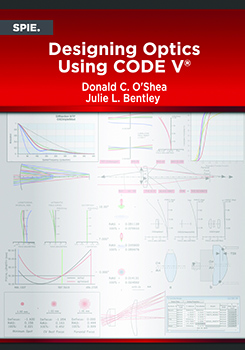|
The purpose of this text is to show you how to design an optical system, using the optical design program, CODE V®. The complete design process (from lens definition to the description and evaluation of lens errors and onto the improvement of lens performance) will be developed and illustrated using the program. The text is organized so that you will be able to (1) reproduce each step of the process including the plots for evaluating lens performance and (2) understand their significance in producing a final design. We chose CODE V because it is a well-regarded, full-featured optical design program that has a command line interface. This text is not a user's manual for CODE V. Synopsys has a set of online reference books for that. Rather, the text starts with a single lens to demonstrate the laws of optics and illustrate the basic optical errors (aberrations) using CODE V. Then, through a series of examples, demonstrations, and exercises, you can follow each step in the design process using the CODE V commands to analyze and optimize the system to meet the required performance specifications. Once the nominal design meets these specs, you can determine a set of tolerances that permits a large fraction of them to be manufactured with an acceptable as-built performance. |
|
|
-
Journals
- Advanced Photonics
- Advanced Photonics Nexus
- Biophotonics Discovery
- Journal of Applied Remote Sensing
- Journal of Astronomical Telescopes, Instruments, and Systems
- Journal of Biomedical Optics
- Journal of Electronic Imaging
- Journal of Medical Imaging
- Journal of Micro/Nanopatterning, Materials, and Metrology
- Journal of Nanophotonics
- Journal of Optical Microsystems
- Journal of Photonics for Energy
- Neurophotonics
- Optical Engineering
- Photonics Insights
- Ebooks
CITATIONS
Code v
Optical design
Monochromatic aberrations
Tolerancing
Lens design
Ray tracing
Imaging systems


